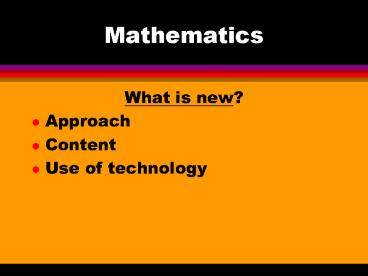Mathematics - PowerPoint PPT Presentation
1 / 20
Title:
Mathematics
Description:
... & N/Rel LO2 Fxns & Alg LO3 Sh/Sp & Mea LO4 Data & Prob. Content Financial mathematics Structural approach to functions Mensuration Transformation geometry ... – PowerPoint PPT presentation
Number of Views:371
Avg rating:3.0/5.0
Title: Mathematics
1
Mathematics
- What is new?
- Approach
- Content
- Use of technology
2
Approach
- Based on a constructivist view of teaching and
learning - Mathematics as a human activity
- Activity based learning
- Mathematical modeling and problem solving
3
Content Link between GET and FET
- GET
- LO 1 Ns No/Rel.
- LO2 Pats, Fxns Algebra
- LO3 Sh Space
- LO 4 Data Prob.
- LO 5 Measurem
- FET
- LO 1 Ns N/Rel
- LO2 Fxns Alg
- LO3 Sh/Sp Mea
- LO4 Data Prob.
4
Content
- Financial mathematics
- Structural approach to functions
- Mensuration
- Transformation geometry
- Other types of geometries
- data handling and probability
5
Technologies
- The use of various technologies depending on
availability
6
Definition of ML
- Role of mathematics in the modern world
- life related applications
- numerical and spatial thinking in order to
- - analyse everyday situations
- - solve problems
7
Purpose
- Everyday life
- Workplace
- Citizenship
8
Purpose
- Everyday life Self managing
- Workplace
- Citizenship
9
Purpose
- Everyday life Self managing
- Workplace Contributing
- Citizenship
10
Purpose
- Everyday life Self managing
- Workplace Contributing
- Citizenship Participating
11
Educational and Career links
- Ability to handle with confidence the mathematics
that occurs in everyday life - Learnerships
- Tertiary study ability to handle math related
requirements in social or life sciences
12
Learning Outcomes
- LO 1 Number and operations in context
- LO 2 Functional relationships
- LO 3 Space, shape and measurement
- LO 4 Data handling
13
LO 1 Number and operations in context
The learner is able to use knowledge of numbers
and their relationships to investigate a range of
different contexts which include financial
aspects of personal, business and national issues
14
LO 2 Functional relationships
The learner is able to recognise, describe and
represent various functional relationships to
solve problems in real and simulated contexts
15
LO 3 Space, Shape and Measurement
The learner is able to measure using appropriate
instruments , to estimate and calculate physical
quantities and to interpret, describe and
represent properties of and relationships between
2D shapes and 3D objects in a variety of
orientations and positions.
16
LO 4 Data Handling
The learner is able to collect, summarise,
display and analyse data and to apply knowledge
of statistical and probability to communicate,
justify and critically interrogate findings and
draw conclusions
17
End of presentation
- Thank You
18
Every day life
- Self managing person
- an insightful use of mathematics in the
management of the needs of everyday living
19
Workplace
- Contributing worker
- an under-standing of mathematics that provides
insight into occupational experiences
20
Citizenship
- Participating citizen
- the ability to voice a critical sensitivity of
the role of mathematicsin a democratic society































